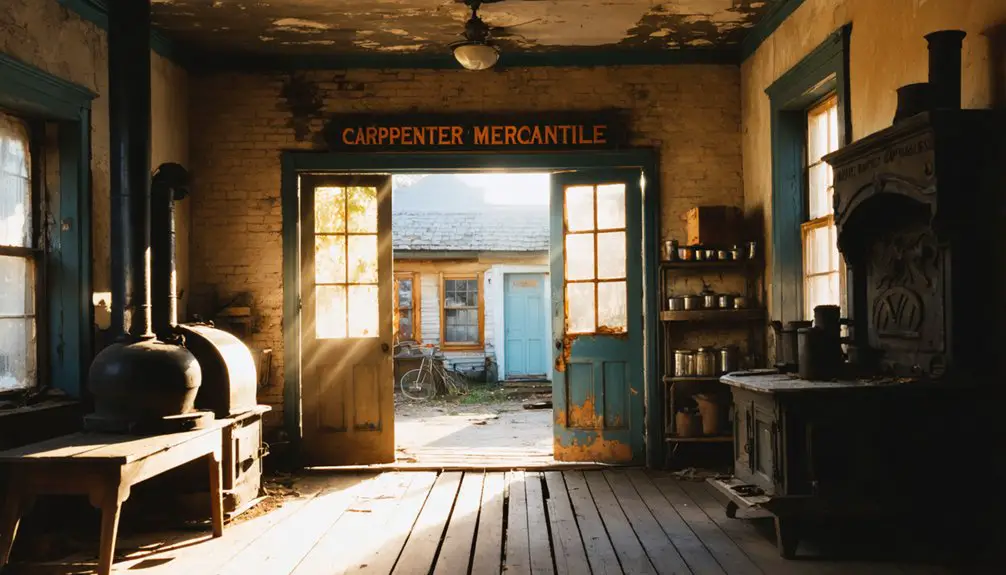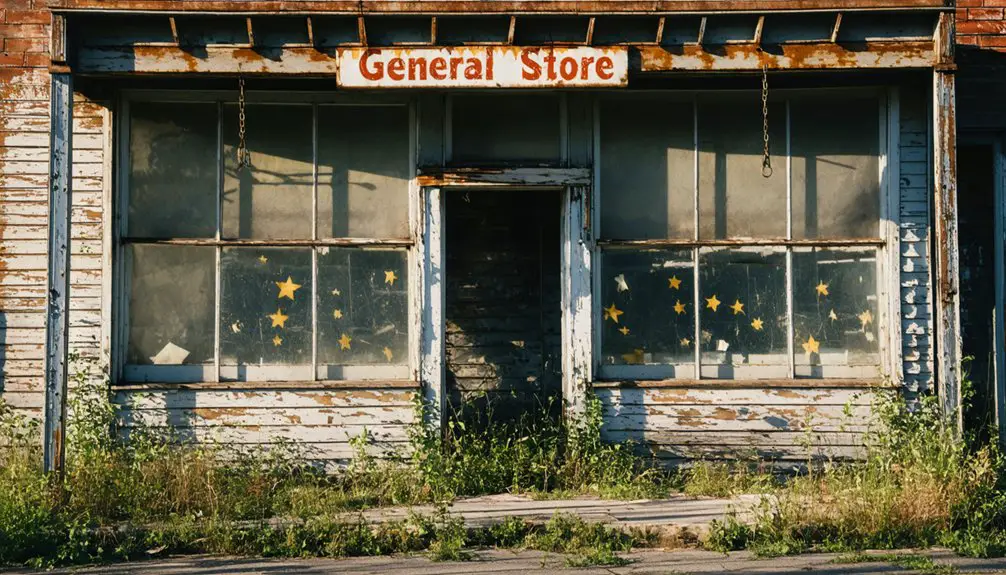You’ll find Carpenter, Oklahoma about eight miles north of Elk City, straddling Roger Mills and Custer counties. Founded in 1898 by Benjamin Carpenter, this ghost town once thrived as a mining community centered around the Book Cliff mines. With a peak population of 50 residents, it featured company stores, boarding houses, and miners’ homes built by William Thomas Carpenter. After the Great Depression and a devastating 1939 tornado, the town declined. Today, weathered buildings and chat piles tell a deeper story of Oklahoma’s industrial past.
Key Takeaways
- Carpenter, Oklahoma was established in 1898 by Benjamin Carpenter and thrived as a mining community near Elk City during the early 1900s.
- The town’s peak population reached 50 residents, supported by Book Cliff mines, a company store, and boarding house.
- Economic decline began in the early 20th century due to resource depletion, with the Great Depression causing an 80% population decrease.
- A 1939 tornado caused extensive damage, contributing to building abandonment and the town’s eventual ghost town status.
- Today, remnants include deteriorating structures, an old church, a cemetery, and chat piles indicating past mining activities.
Early Settlement and Community Formation
While settlers were actively moving into western Oklahoma Territory in the late 1890s, Benjamin Carpenter’s arrival from Texas in 1898 marked the beginning of what would become the community of Carpenter.
As settlers ventured into western Oklahoma Territory, Benjamin Carpenter’s 1898 arrival set the foundation for a new frontier community.
You’ll find that settler experiences in this region centered on ranching activities, with Carpenter and others bringing their livestock and frontier expertise from Texas to establish new lives.
The community’s formal recognition came on March 19, 1901, when you could first visit the local post office.
Located about eight miles north of Elk City, straddling Roger Mills and Custer counties, the settlement reflected typical community dynamics of the era.
Like many frontier towns, Carpenter emerged from informal ranching networks into a recognized settlement, though it remained unincorporated throughout its existence.
Much like the town of Elgin, the community initially thrived as a cattle shipping point, connecting ranchers to vital transportation networks.
The settlement followed patterns similar to other Oklahoma boomtowns and mining towns that would later become ghost towns.
Life in Carpenter’s Golden Years
During Carpenter’s peak years in the early 1900s, the small mining town centered its existence around the operations of the Book Cliff mines, with housing and infrastructure carefully designed to support its workforce.
You’d find miners and their families living in small houses built by William Thomas Carpenter, while the company store and boarding house served as hubs for community gatherings. Similar to Gray Horse village, the town’s economy relied heavily on natural resources.
The mining culture shaped daily life, with stonecutters and masons adding local character by constructing buildings from sandstone. Skilled journeyperson carpenters were essential for maintaining the town’s wooden structures and creating custom fixtures.
While the town never grew beyond 50 residents, you’d witness a close-knit community sharing spaces and resources.
Though plans existed to transform Carpenter into a tourist destination with a hotel and dance pavilion, the town remained primarily focused on serving its mining population.
Economic Struggles and Population Decline
The economic foundations of Carpenter began to crumble in the early twentieth century, following patterns common to many Oklahoma towns dependent on single industries.
Economic dependency on resource extraction and agriculture proved unsustainable as local resources faced exhaustion and market conditions shifted.
Like many other oil boom towns, Carpenter experienced rapid growth followed by steep decline.
You’ll find these key factors contributed to Carpenter’s decline:
- Natural resource depletion, particularly in oil fields
- Agricultural mechanization reducing local job opportunities
- Railroad route changes that diminished trade accessibility
- Limited economic diversification leaving the town vulnerable
- Migration of younger residents to urban centers for better opportunities
The Great Depression hit the community particularly hard, paralleling the widespread economic devastation that caused numerous Oklahoma towns to decline.
The town’s population plummeted by over 80%, leading to widespread abandonment of buildings and infrastructure.
Schools closed, businesses shuttered, and community services became unsustainable as the tax base shrank, accelerating the exodus of remaining families.
Notable Buildings and Infrastructure
Several notable structures remain as silent witnesses to Carpenter’s former energy, with abandoned buildings scattered across the ghost town’s landscape.
You’ll find an abandoned church building that once served as the community’s spiritual center, standing as a symbol of the town’s religious heritage.
Like many neglected sites across Oklahoma, piles of rubble and deteriorating structures dot the landscape where buildings once stood.
Throughout the area, you can spot remnants of commercial infrastructure, including old general stores and service stations that once bustled with activity.
The town’s cemetery continues to exist as one of the most enduring physical reminders of the community. Following the destructive impact of the 1939 tornado, many buildings in the region required extensive repairs or were abandoned entirely.
Beyond the decaying structures and empty streets, Carpenter’s cemetery stands eternal, preserving the memory of those who called this place home.
You might notice abandoned houses and duplex units, their deteriorating frames reflecting early 20th-century Oklahoma architecture.
While many buildings have lost their roofs and structural integrity, these remaining landmarks offer glimpses into Carpenter’s more prosperous days.
Legacy of Rural Exodus
Devastating agricultural hardships and economic collapse during the 1930s triggered a mass exodus from Carpenter and countless other Oklahoma farming communities. The migration transformed the region’s rural resilience and community identity, as over 440,000 Oklahomans left their homes during this tumultuous decade. Many departing families followed Route 66 westward to seek opportunities in California. The town’s challenges echoed earlier local tensions seen during the Green Corn uprising of the previous generation.
The exodus’s lasting impact on Carpenter included:
- Permanent loss of essential agricultural families and workers
- Closure of local businesses and schools as population dwindled
- Breakdown of traditional social networks and community bonds
- Consolidation of farmland as small farmers and tenants were displaced
- Transformation from a thriving farming town to a ghost town
These dramatic changes weren’t just about losing population – they represented the end of a way of life that had defined Carpenter’s character since its founding.
Present-Day Remnants and Access
Modern visitors to Carpenter’s remnants will find a stark, contaminated landscape dominated by mining waste heaps and scattered structural foundations.
You’ll encounter warning signs and crumbling concrete amid overgrown vegetation, with toxic hazards limiting your remnant exploration to designated perimeter areas.
The Quapaw Nation now manages most of the land, working with the EPA to address the severe lead and zinc contamination that forced the town’s abandonment.
You can’t safely enter any remaining structures, and there aren’t any visitor facilities or guided tours available.
While you might spot old signs pointing to former churches and stores, the site primarily serves as a sobering reminder of industrial decline.
The brown and gray landscape, marked by chat piles, tells the story of environmental devastation that continues to shape access restrictions.
Historical Preservation Efforts

Despite Carpenter’s minimal remaining structures, you’ll find preservation efforts focused on documenting the site through photographs and written records maintained by the Roger Mills and Custer County historical societies.
Local historians work to collect oral histories from descendants of early settlers, adding personal narratives to complement the physical documentation of building foundations and cemetery plots.
You can access growing digital archives of Carpenter’s history through state historical databases and online platforms, though these collections remain limited due to the town’s relatively brief existence.
Documenting Remaining Structures
While efforts to document Carpenter’s remaining structures have largely focused on photographic records and GPS mapping, preservationists face significant challenges in their mission to catalog this Oklahoma ghost town’s architectural heritage.
Through photographic documentation and architectural analysis, you’ll find most structures in advanced stages of deterioration, with many buildings reduced to foundations or skeletal remains.
Current documentation methods include:
- Drone imaging to capture extensive aerial views
- 3D laser scanning for detailed structural modeling
- University-led survey projects
- Digital archiving of remaining signage and architectural features
- Virtual tour development for remote access
Weather damage, property ownership issues, and lack of funding continue to hamper preservation efforts.
You’ll notice most buildings have missing roofs, rotted wooden frames, and only their most durable elements, like concrete foundations, remain intact.
Local Historical Society Activities
The Oklahoma Historical Society (OHS) leads a robust network of preservation initiatives to safeguard Carpenter’s remaining heritage.
You’ll find their grant program actively supporting local preservation projects with awards up to $25,000, enabling crucial documentation and restoration work in ghost towns like Carpenter. Through community outreach, OHS collaborates with local historic preservation commissions to guarantee thorough public review of National Register nominations.
You can participate in the preservation process through local engagement opportunities coordinated by OHS’s partner organizations.
Their strategic plan, “Preservation and Perseverance: Care Before It’s Gone,” emphasizes expanding awareness across Oklahoma communities.
While federal funding challenges persist, OHS continues managing historical sites and museums statewide, ensuring places like Carpenter don’t fade from memory.
Digital Archive Development
Since Carpenter’s physical remains continue diminishing, digital preservation efforts have become vital to safeguarding its historical legacy.
You’ll find cutting-edge archival technology being deployed to capture and preserve every aspect of this former mining town’s history. Through collaborative partnerships with museums and universities, extensive digital archives are bringing Carpenter’s past into the future.
- 3D scanning and drone imaging document remaining structures and layout
- GIS mapping integrates historical data with current terrain analysis
- Virtual and augmented reality reconstructions offer immersive historical experiences
- Digital collections include photos, documents, and mining records
- Environmental and geological data provide context for the town’s decline
These preservation initiatives guarantee that while Carpenter’s physical presence may fade, its story won’t be lost to time.
Frequently Asked Questions
Were Any Movies or Television Shows Ever Filmed in Carpenter?
You won’t find any movies or TV shows filmed in this remote location, as there’s no documented evidence of film locations or haunted sites being used for productions here.
What Native American Tribes Originally Inhabited the Carpenter Area?
You’ll find the Muscogee (Creek) Nation and Cherokee Nation were the primary Native tribes of historical significance in this area, though Agricultural Villagers inhabited the region over 1,000 years earlier.
Did Carpenter Experience Any Significant Natural Disasters During Its Existence?
You won’t find historical records of any significant natural disasters affecting Carpenter. While Oklahoma’s prone to severe weather, there’s no documented evidence of storms or other events impacting this ghost town’s existence.
Are There Any Documented Paranormal Activities or Ghost Stories From Carpenter?
You won’t find any documented ghost sightings or haunted locations from Carpenter – surprisingly rare for an Oklahoma ghost town. Historical records and paranormal databases show no supernatural activity reported from this area.
What Was the Highest Recorded Population of Carpenter in Its History?
You’ll find that Carpenter’s highest population reached 695 residents in 1930, marking its peak of historical significance before declining. That’s the largest number of people who’ve ever called this community home.
References
- https://www.youtube.com/watch?v=xg8SpCG-wDg
- https://www.youtube.com/watch?v=08y9RTS_nS4
- https://en.wikipedia.org/wiki/Picher
- https://newforums.com/our-titles/best-of-the-region/places-routes/ghost-town-tales-of-oklahoma-unforgettable-stories-of-nearly-forgotten-places/
- https://kids.kiddle.co/List_of_ghost_towns_in_Oklahoma
- https://legendsofkansas.com/elgin-kansas/
- https://en.wikipedia.org/wiki/List_of_ghost_towns_in_Oklahoma
- https://www.youtube.com/watch?v=-jYN1_E2VV0
- https://okcfox.com/news/local/oklahomas-secret-past-ghost-towns-of-oklahoma
- https://en.wikipedia.org/wiki/Carpenter



